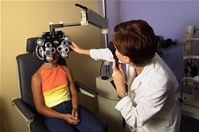Limitations of Vision Screening Programs
- What are the limitations of vision screening programs?
- How is a comprehensive eye and vision examination different from a vision screening?
Vision screening programs are intended to help identify children or adults who may have undetected vision problems and refer them for further evaluation. However, they can't be relied on to provide the same results as a comprehensive eye and vision examination.
 Screenings can take many forms. Often schools provide periodic vision screenings for their students. A pediatrician or other primary care physician may do a vision screening as part of a school physical. When applying for a driver's license, chances are your vision will be screened. Many times vision screenings are part of local health fairs put on by hospitals, social service agencies or fraternal groups like the Lions and Elks Clubs.
Screenings can take many forms. Often schools provide periodic vision screenings for their students. A pediatrician or other primary care physician may do a vision screening as part of a school physical. When applying for a driver's license, chances are your vision will be screened. Many times vision screenings are part of local health fairs put on by hospitals, social service agencies or fraternal groups like the Lions and Elks Clubs.While vision screenings can uncover some individuals with vision problems, they can miss more than they find. This is a major concern about vision screening programs.
Current vision screening methods cannot be relied upon to effectively identify individuals in need of vision care. In some cases, vision screening may actually serve as an unnecessary barrier to an early diagnosis of vision problems. They can create a false sense of security for those individuals who "pass" the screening, but who actually have a vision problem, thereby delaying further examination and treatment. Vision screening programs may also result in unnecessary referral for further evaluation of persons who are found not to have an eye or vision problem.
Undetected and untreated vision problems can interfere with a child's ability to learn in school and participation in sports or with an adult's ability to do their job or to drive safely. The earlier a vision problem is diagnosed and treated, the less it will impact an individual's quality of life.
What are the limitations of vision screening programs?
To understand why vision screenings may not find a vision problem, we need to look at the factors that can limit their effectiveness.
- Limited testing - Many vision screenings test only for distance visual acuity. While the ability to see clearly in the distance is important, it does not give any indication of how well the eyes focus up close, or work together. It also does not give any information about the health of the eyes.
Some screenings may also include a plus lens test for farsightedness and a test of eye coordination. However, even these additional screening tests will fail to detect many vision problems.
- Untrained personnel - Often times a vision screening is conducted by administrative personnel or volunteers who have little training. While well intentioned, these individuals do not have the knowledge to competently assess screening results.
- Inadequate testing equipment - Even when done in a pediatricians' or primary care physicians' office, the scope of vision screening may be limited by the type of testing equipment available. Factors such as room lighting, testing distances and maintenance of the testing equipment can also affect test results.
[back to top]
How is a comprehensive eye and vision examination different from a vision screening?
 A comprehensive eye and vision examination can only be conducted by an optometrist or ophthalmologist, who has the specialized training needed to make a definitive diagnosis and prescribe treatment. In addition,
A comprehensive eye and vision examination can only be conducted by an optometrist or ophthalmologist, who has the specialized training needed to make a definitive diagnosis and prescribe treatment. In addition,A comprehensive adult eye and vision examination includes:
- Patient and family health history
- Visual acuity measurement
- Preliminary tests of visual function and eye health including depth perception, color vision, peripheral vision and response of the pupils to light
- Assessment of refractive status to determine the presence of nearsightedness, farsightedness or astigmatism
- Evaluation of eye focusing, eye teaming and eye movement abilities
- Eye health examination
- Additional tests as needed
Even if a child or adult passes a vision screening, they shouldn't assume that they don't have an eye health or vision problem. Professional examinations are the only effective way to confirm or rule out the presence of any eye disease or vision problem. The American Optometric Association recommends the following frequency of eye and vision examinations by age.
Frequency of Examination
Birth to 24 Months
At 6 months of age
At 6 months of age oras recommended
2 to 5 years
At 3 years of age
At 3 years of age or as recommended
6 to 18 years
Before first grade and every two years thereafter
Annually or as recommended
18 to 60 years
Every two years
Every one to two years or as recommended
61 and older
Annually
Annually or as recommended
[back to top]
